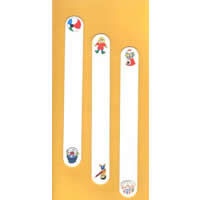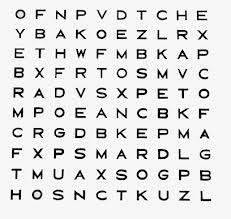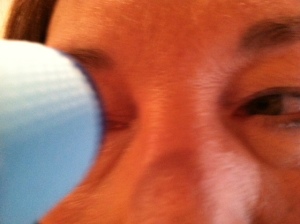In the preceding blog entry we discussed discriminative hand and finger movement as a prelude to graphic control according to the model presented by Dr. Wachs in his therapy manual. In his section on Ocular Discriminative Movement, Harry emphasizes efficient and purposeful control of eye movements, rooted in visual thinking. Adequacy in focusing, tracking, saccades, and convergence is vital for all near vision tasks, and inadequacy can lead to impairment, stress, fatigue, discomfort or avoidance.
The notion of symptoms receives alot of attention, thanks in large measure to excellent inventories such as the Convergence Insufficiency Symptom Survey (CISS). But what Harry is pointing out here, quite aptly, is that the absence of symptoms doesn’t necessarily mean the absence of problems. I find myself falling into this trap at times, tempted to advise that if a patient is asymptomatic there is little likelihood of compliance with interventions that we might prescribe. Or that interventions imply prevention of a problem when symptoms are absent. The point is, a problem exists, but the patient is either in denial or has learned to avoid the tasks or activities that would elicit symptoms. The COVD Quality of LIfe Checklist addresses this by noting whether a child avoids reading or near work, or says “I can’t” before trying. Avoidance is therefore a clinical sign, and one that warrants more of our attention.
We tend to place alot of emphasis on binocularity, or effective and efficient use of both eyes together as a team. But Harry opens his section on Ocular Discriminative Movement with procedures on Monocularity. Traditionally we think of this as what one eye can do in isolation, as when an eye is patched, but Dr. Wachs refers to a specific aspect of what one eye can do while both eyes are open. What he describes sounds more like a variant of monocular fixation in a binocular field (MFBF). In the early part of Harry’s career he was quite proficient with and occupied in contact lens practice, and he gives fellow contact lens pioneer Newton K. Wesley credit for drawing attention to a condition in which one eye cannot fixate in the nasal field when both eyes are open, but can fixate when the other eye is closed.
Monocularity
 Dr. Wachs suggests using a small flashlight with the letter “E” as the fixation target at the edge of the light, but I would imagine any discrete target of interest would do that allows the patient report when the item is blurred rather than clear. The child keeps both eyes open, with the lit flashlight about half an inch from one of the eyes. Start at the temporal field (toward the ear on that side) and have her track the light in a circle toward the nasal field while keeping the letter in focus. The eyes should move but the head remains still, and if the target or letter blurs, move the light temporally again until the target is clear. Do this clockwise and counterclockwise until she can keep the target clear through a 360 degree rotation in front of the one eye. Here’s the key: you want to see the opposite eye converging to the nose, as if t could see the target even though it’s blocked by the nose from viewing it. If the patient’s nose is too small (hard for me to identify with) use a septum to block the opposite eye’s view of the target. Once this can be done with a light do it with the fixation stick, which requires more focus.
Dr. Wachs suggests using a small flashlight with the letter “E” as the fixation target at the edge of the light, but I would imagine any discrete target of interest would do that allows the patient report when the item is blurred rather than clear. The child keeps both eyes open, with the lit flashlight about half an inch from one of the eyes. Start at the temporal field (toward the ear on that side) and have her track the light in a circle toward the nasal field while keeping the letter in focus. The eyes should move but the head remains still, and if the target or letter blurs, move the light temporally again until the target is clear. Do this clockwise and counterclockwise until she can keep the target clear through a 360 degree rotation in front of the one eye. Here’s the key: you want to see the opposite eye converging to the nose, as if t could see the target even though it’s blocked by the nose from viewing it. If the patient’s nose is too small (hard for me to identify with) use a septum to block the opposite eye’s view of the target. Once this can be done with a light do it with the fixation stick, which requires more focus.
Calisthenics
Awhile back I blogged about ocular calisthenics as physical therapy for the eyes, and here is where Harry notes that these eye exercises are to eye movement what stretching is to body movement – the can help achieve proper voluntary sensory motor control thereby relieving stress and improving flexibility of all eye movements.
Open Eye Swings – Holding her head still in straight ahead gaze, the patient moves both eyes up, down, extreme right and extreme left, holding the end point positions in each quadrant for a few seconds.
Closed Eye Swings – Same as above, but periodically say “freeze” as ask patient to point in the direction which she feels her eyes are pointing, then open her eyes to see if where she is pointing matches where her eyes are fixating.
Head Swings – This time the eyes remains still to maintain fixation, but the head rotates L/R/U/D/Clockwise/CCW. This is essentially a series of doll’s eye movements.
Focus
Rock Stick
 This is what many of us refer to as accommodative rock. The patient begins fixating at a distance, then re-focuses to a stick progressively moved as close to the nose as possible while the letters on the stick remain clear. It follows the monocularity procedure above, with both eyes open, and use of a septum to block the other eye from viewing the target as needed. When the maximum nearpoint at which the letters remain clear is found, the patient should trombone the stick in and out to toggle between clear and slightly blurred. You’re not looking for the letters to blur out totally.
This is what many of us refer to as accommodative rock. The patient begins fixating at a distance, then re-focuses to a stick progressively moved as close to the nose as possible while the letters on the stick remain clear. It follows the monocularity procedure above, with both eyes open, and use of a septum to block the other eye from viewing the target as needed. When the maximum nearpoint at which the letters remain clear is found, the patient should trombone the stick in and out to toggle between clear and slightly blurred. You’re not looking for the letters to blur out totally.
Hart Chart
 Harry suggests using the near/far Hart Chart, a 10 letter grid of 10 rows with a large chart at distance and a reduced size version for near, in a way described by Dr. Arnie Sherman. We call it Hart Chart 100. Basically you’re giving the child locations to find, so it combines some cognition in terms of visual search together with eye movement accuracy and accommodative flexibility. For example, find the fifth letter in the sixth row at distance, then the seventh letter in the fourth row at near. As with some of the other activities, you’re going to have to start at a simpler level first with many of the populations we deal with, and try to work your way up to this stage. That is implied in the way Dr. Wachs approaches modifying the activities when they prove to be difficult. Here’s a nice site for making your own.
Harry suggests using the near/far Hart Chart, a 10 letter grid of 10 rows with a large chart at distance and a reduced size version for near, in a way described by Dr. Arnie Sherman. We call it Hart Chart 100. Basically you’re giving the child locations to find, so it combines some cognition in terms of visual search together with eye movement accuracy and accommodative flexibility. For example, find the fifth letter in the sixth row at distance, then the seventh letter in the fourth row at near. As with some of the other activities, you’re going to have to start at a simpler level first with many of the populations we deal with, and try to work your way up to this stage. That is implied in the way Dr. Wachs approaches modifying the activities when they prove to be difficult. Here’s a nice site for making your own.
Fixation & Tracking
There are so many goodies here I’m just going to list them with a brief comment (well, Wolff Wands won’t be brief).
Intelligent Tracking – track with thinking rather than robotically. Worth noting that unlike copying geometric forms, where children organize vertically before horizontally, lateral tracking develops before vertical. When you stop moving the target, such as a pen, penlight, or Wolff wand, the child should be able to stop immediately rather than being fooled by anticipatory patterns.
Pen Stab, Paper Stab, Washer Stab, Manual Tracking, Bubble Pop. Read the manual.
Wolff Wands
 I like Harry’s descriptor of making this into a game. Wolff wands are available through Richmond Products. Though you could use any paired target of interest, I like the silver ball and gold balls on the wands as targets. Hold the wands at about 50 cm splitting the midline symmetrically, one ball to the left and one to the right. After confirming what they call the color (if they call the silver one gray, and the gold one yellow, go with those labels) I ask the child to look at either the gold or the silver depending on which color I say. With patients who aren’t ready to ride the bucking bronco with their eyes, you may need to remind them to continue to look at whichever target you called out last. As a plug for an OEP monograph I recently completed, our sequence for doing this procedure is laid out in Parallels Between Auditory & Visual Processing, pages 57-59.
I like Harry’s descriptor of making this into a game. Wolff wands are available through Richmond Products. Though you could use any paired target of interest, I like the silver ball and gold balls on the wands as targets. Hold the wands at about 50 cm splitting the midline symmetrically, one ball to the left and one to the right. After confirming what they call the color (if they call the silver one gray, and the gold one yellow, go with those labels) I ask the child to look at either the gold or the silver depending on which color I say. With patients who aren’t ready to ride the bucking bronco with their eyes, you may need to remind them to continue to look at whichever target you called out last. As a plug for an OEP monograph I recently completed, our sequence for doing this procedure is laid out in Parallels Between Auditory & Visual Processing, pages 57-59.
Flashlight Tag – not to be confused with the children’s party game, this one has the therapist move the flashlight as the target on a blank wall, and the patient superimposes their flashlight on it.
Transparent Board Tracking – Harry is fond of reversibility, and this is a prelude to the kind of visual thinking that he extends into logs and parquetry blocks, but here is done with tracking.
 Hold a transparent board between you and the child with one hand, and with the other draw on the plexiglas board with a marker, and ask the child to track your path with his finger. Then switch it around, where you move your finger and the child has to follow your path with his finger. You can have many variations of the theme, for example spelling a word with your finger and asking the child to follow it on the board. You have to remember to do all the objects, letters, pictures, etc. in reverse so that the what the child does with the marker looks correct! If you’re not good at mirror reversibility yourself, well …
Hold a transparent board between you and the child with one hand, and with the other draw on the plexiglas board with a marker, and ask the child to track your path with his finger. Then switch it around, where you move your finger and the child has to follow your path with his finger. You can have many variations of the theme, for example spelling a word with your finger and asking the child to follow it on the board. You have to remember to do all the objects, letters, pictures, etc. in reverse so that the what the child does with the marker looks correct! If you’re not good at mirror reversibility yourself, well …


